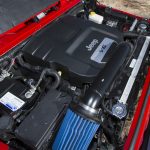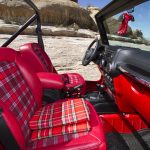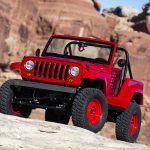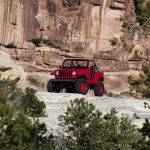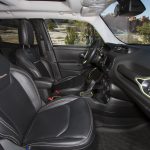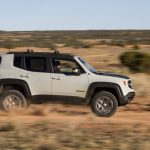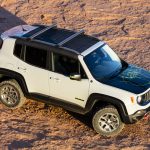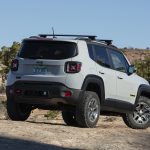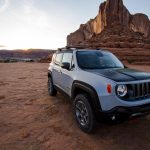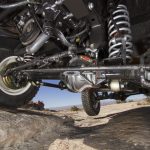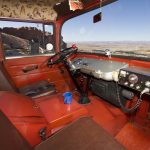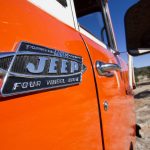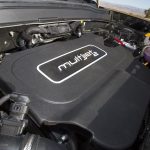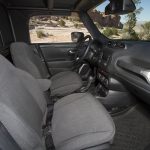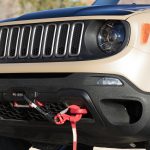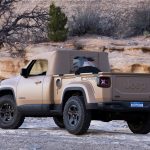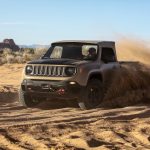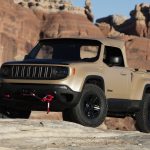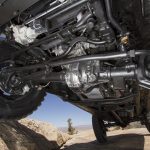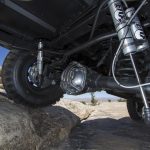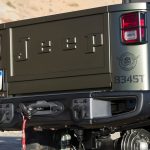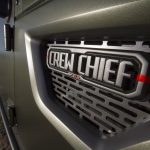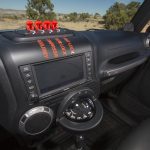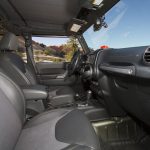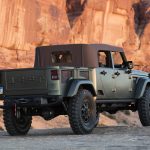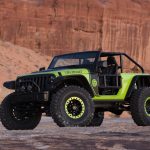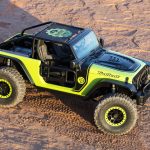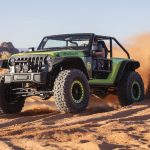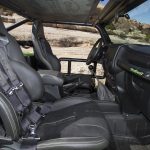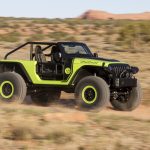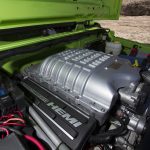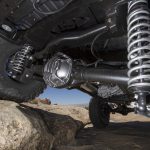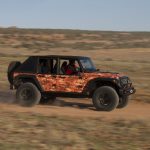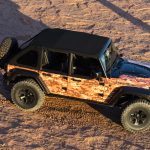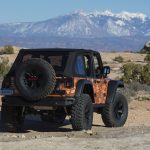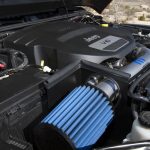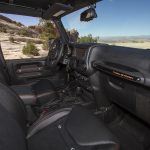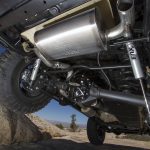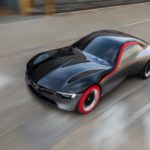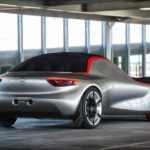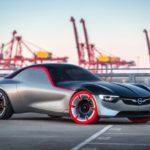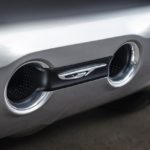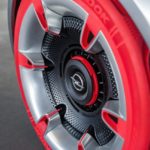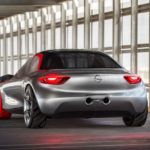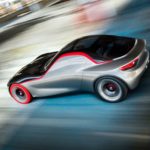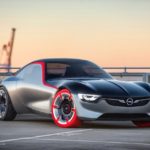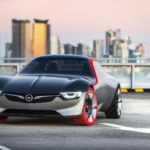Archives for :
Concepts
The Easter Jeep Safari is an event consisting of day-long trail rides, departing from Moab, Utah, throughout the nine-day-long event. The Jeep Safari was started in 1967 by the Moab Chamber of Commerce as a one-day trail ride. Over the years, as participation grew, the Safari expanded until it finally reached the current nine-day event. “Big Saturday†still remains the culmination of the event on the Saturday of Easter weekend. This year Jeep bring several in-house projects to the event to push the brand and show off their after-market range.
Seven new, ultra-capable Jeep® concept vehicles – featuring an array of Mopar and Jeep Performance Parts available to consumers – will conquer the famous and challenging trails of Moab, Utah, at Easter Jeep Safari, March 19-27. Thousands of off-road enthusiasts are expected to descend upon Moab this year to celebrate what will likely be the most popular Jeep Safari ever, as the 50th annual event coincides with the 75th anniversary of the Jeep brand.
“Every year the Jeep team looks forward to pushing the limits with new, exciting and capable concept vehicles for our most loyal enthusiasts at the Easter Jeep Safari in Moab, where we receive a tremendous amount of valuable feedback,†said Mike Manley, Head of Jeep Brand – FCA Global. “This year is extra special, as together with our biggest fans, we celebrate Jeep’s 75th anniversary – as well as the 50th running of the Jeep Safari. We’re delighted to share seven of the most capable and eye-catching concept Jeep vehicles we’ve ever created at this year’s historic event.â€
The 2016 crop of Easter Jeep Safari concept vehicles utilises both production and prototype Jeep Performance Parts. The Mopar brand is responsible for developing, building and ensuring that all Jeep Performance Parts meet rigorous specifications and with 4×4 capabilities in mind, allowing Jeep owners to further enhance their stock vehicle.
“These seven vehicles have been modified with Mopar and Jeep Performance Parts to take on the toughest trails, to go beyond where the road ends,†said Pietro Gorlier, Head of Parts and Service (Mopar), FCA – Global. “Mopar’s mission is to provide all FCA US vehicle owners with unique performance parts and accessories to tailor vehicles to their individual lifestyles. Nothing supports that more than demonstrating how we can equip Jeep owners to take on some of the more extreme trails in the world.â€
The seven new Jeep concept vehicles built for Moab this year were created by a team of dedicated, passionate engineers, designers and fabricators that have been customizing production vehicles since 2002, and have introduced more than 50 concept vehicles for the enthusiasts who attend the popular Easter Jeep Safari.
The 2016 Easter Jeep Safari concept vehicles include:
Jeep Crew Chief 715
The Jeep Crew Chief 715 concept vehicle was built as a salute to legendary Jeep military service vehicles, in particular the Kaiser M715. This open-air Wrangler Unlimited-based concept vehicle showcases a burly design with heritage styling cues. The Crew Chief 715 utilizes modern-day construction with a rear seat and extra doors for additional passenger capacity while staying close to its classic military roots.
Original Jeep military service vehicles were legendary for getting troops through rugged terrain, and the Jeep Crew Chief 715 illustrates this legacy. Steel front and rear bumpers, 20-inch beadlock wheels, and 40-inch NDT military tires pay homage to the original Jeep military vehicles. The Crew Chief 715 utilizes an on-board air system with a hard-mounted quick-disconnect fitting for airing up or lending assistance to other vehicles on the trail. Other features include a master cylinder brake upgrade, cold air intake and a modified exhaust.
Exterior features such as Jeep Performance Parts off-road rock rails, a winch mounted into the front and rear bumpers, Dana 60 front and rear axles and a 4-inch lift kit with Jeep Performance Parts/Fox 2.0 Remote Reservoir shocks give the Crew Chief 715 increased capability. The “Tactical Green†color scheme runs from the custom modified M715-inspired front-end to the tailgate. The Crew Chief 715 features a military themed 5-foot cargo bed.
Inside, the no-nonsense interior features leather bucket seats with canvas inserts, aircraft-inspired control switches and Mopar all-weather mats. The media center features a centrally located navigational compass.
The Jeep Crew Chief 715 is powered by the 3.6-liter Pentastar V-6 engine and is mated to a five-speed automatic transmission.
Jeep Shortcut
A carefully crafted take on the beloved Jeep CJ-5, this Wrangler-based concept vehicle invokes the spirit of 1950s Americana with a shortened body and functional simplicity.
Exterior styling cues include a unique grille, hood, tailgate, front and rear wheel flares and custom chrome front and rear bumpers. A modified exhaust, 17-inch red steel wheels and 35-inch BF-Goodrich Mud-Terrain T/A KM2 tires help the Jeep Shortcut maintain the look of an icon.
Jeep Performance Parts featured on the Shortcut include a front and rear Dana 44 axle and a 2-inch lift with Fox shocks. Overall body length has been reduced by more than 12 inches to keep the Shortcut concept vehicle light and maneuverable on the trails.
Inside, the simple yet functional interior features low-back leather bucket seats with plaid inserts, a red ball shifter handle, four-point safety cage and Mopar all-weather mats.
The Jeep Shortcut is powered by the 3.6-liter Pentastar V-6 engine and mated to a 5-speed automatic transmission.
Jeep Renegade Commander
The Jeep Renegade Commander concept vehicle is equipped with an assortment of Mopar and Jeep Performance Parts for the ultimate off-road adventure. A 2-inch lift kit and 17-inch Rubicon aluminum wheels with 29.5-inch BF-Goodrich All-Terrain T/A KO2 tires increase the off-road capabilities of the Jeep Renegade Commander.
The “Fluorescent Gray†exterior features Renegade’s MySky open-air roof with removable panels, custom body decal, Mopar off-road rock rails, skid plates and a modified exhaust. Also featured are the Mopar brand’s trailer hitch receiver and front and rear auxiliary lights.
Inside, the Renegade Commander includes Katzkin seat covers, body color bezel accents, a pedal kit, Mopar off-road kit and Mopar all-weather floor mats.
The Jeep Renegade Commander is powered by the 2.4-liter Tigershark engine with MultiAir2 mated to a 9-speed automatic transmission with Jeep Active Drive Low.
Jeep Comanche
Based on the Jeep Renegade, the Jeep Comanche concept vehicle is designed to be off-road ready with practical utility. A nod to Jeep pickup trucks of years past, the Comanche concept takes styling cues from military and civilian Jeep heritage.
The Comanche’s “Beige Against the Machine†concept exterior paint is accented with a Satin Black hood, a concept lower front fascia, winch, steel rear bumper, soft top, and spare tire in the bed. The wheelbase has been stretched an additional six inches versus a production Renegade to accommodate Comanche’s 5-foot bed.
Inside, the Comanche features custom seat covers, pedal covers, door sill guards, and Mopar all-weather mats. Jeep Performance Parts like off-road rock rails, a 2-inch lift kit and a winch bolster the Comanche’s off-road capability. The Comanche rolls on 16-inch painted wheels and 32-inch BF-Goodrich All Terrain T/A tires.
The Jeep Comanche is powered by a 2.0-liter diesel I-4 engine and mated to a 9-speed automatic transmission with Jeep Active Drive Lock, which includes low range and a locking rear differential.
Jeep FC 150
A true American workhorse, this 1960 Jeep FC 150 concept vehicle is rich with heritage and built to tackle both challenging rocky trails and the harshness of a western cattle ranch. Originally built from 1956 to 1965, the FC 150 is based on the CJ-5 and offered a clever packaging solution by keeping overall length to a minimum for maneuverability, but maintained a full-length cargo box for utility.
This heritage Jeep vehicle continues to utilize its original steel body that proudly bears battle scars while components underneath have been revamped. The FC 150’s off-road prowess has been enhanced courtesy of a 2005 Jeep Wrangler chassis modified to accept a Dana 44 front axle, Dana 60 rear axle and 17-inch white steel wheels wrapped in 33-inch BF-Goodrich Mud-Terrain T/A KM2 tires.
Inside, the FC 150 features vinyl seat covers, a custom headliner wrapped in a vintage duck hunting pattern, CB radio, analog compass and Mopar all-weather mats.
The Jeep FC 150 heritage vehicle is powered by a 4.0-liter PowerTech I-6 and is mated to a 3-speed automatic transmission.
Jeep Trailcat
The Jeep Trailcat concept vehicle is the ultimate off-road machine, equally at home on Moab’s rugged trails or a high-speed section. Utilizing the supercharged 6.2-liter HEMI® Hellcat V-8 engine, and mated to a 6-speed manual transmission with a custom shifter ball featuring an embossed Hellcat logo, the Trailcat concept vehicle leaves everything else in a cloud of dust.
To get the 707-horsepower Hellcat engine into the Trailcat, designers stretched the wheelbase an additional 12 inches while chopping the windshield two inches for a sleeker look. Mopar exterior enhancements include a power dome vented hood, Satin Black grille, LED headlamp and fog lamps and rock rails.
The robust off-road look is further aided by steel front and rear bumpers, 17-inch beadlock wheels and 39.5-inch BF-Goodrich Krawler T/A KX tires, front and rear Dana 60 axles and Fox shocks.
Subtle design cues, such as a Hellcat decal on the front quarter panels and a “Trailcat†decal on the side of the hood, hint at the horsepower that lurks beneath, making this much more than a typical production Wrangler. The Trailcat’s interior is simple yet functional and features sport bucket seats from the Dodge Viper, made from carbon fiber and featuring Katzkin leather seat covers with accent stitching.
Jeep Trailstorm
The Trailstorm concept vehicle is the ultimate Jeep Wrangler for exploring off the beaten path. Offering room for extra gear and fuel tanks, it is based on the Jeep Wrangler Unlimited, and delivers elevated capability to conquer trails with ease.
Off-road capabilities are enhanced with several Jeep Performance Parts, including 17-inch concept off-road wheels wrapped in 37-inch tires, a 2-inch lift kit with Jeep Performance Parts/Fox shocks, a Jeep Performance Parts Rubicon winch, and Dana 44 front and rear axles. Half doors offer a clear view of obstacles ahead and a bedlined interior makes cleaning up after a day on the trails easy.
Mopar exterior enhancements include a winch guard, Satin Black grille, LED headlights and fog lights, high top fenders, power-dome vented hood, Mopar off-road rock rails with a step, Big Brake Kit, a concept fast-back soft top, tail light guards and a Mopar fuel filler door. Finishing the Trailstorm’s exterior upgrades are a steel front and rear Rubicon bumper and a Jeep Performance Parts tire carrier. The Trailstorm is wrapped in camouflage allowing it to blend into its surroundings in the Utah desert.
The Trailstorm’s bedlined interior also features Katzkin seat covers and Mopar all-weather floor mats. The Jeep Trailstorm is powered by a 3.6-liter Pentastar V-6 engine and is mated to a 5-speed automatic transmission.
IED and Quattroruote in Geneva present the latest concept car by the Master in Transportation Design, a self-driving vehicle that focuses on the user experience. After an initial collaboration started in 2015, the two organisations have partnered again on the occasion of their anniversaries: in 2016 they celebrate 50 years since the first IED creative graduate and 60 years from the first issue of the magazine that would become an international leader in the automotive world.
Shiwa (4,700mm long, 2,000mm wide, 1,500 high and with a 3,660mm wheelbase) is a noiseless zero emissions self-driving vehicle with four seats and four electric motors integrated in the drivetrain. Shiwa – a Japanese word meaning “fold†– indicates the form/action able to transform a surface without resistance into a self-supporting object, as in origami: the fold gives form and function to a surface which otherwise would lack them. This is the initial concept from which the Korean student Youngjin SHIM drafted her project, which was then developed by a team composed of her and eleven other Master students, including the Italian Luca MENICACCI and the Indian Jaykishan Vithalbhai LAKHANI. The external structure of the concept is inspired by the fold/origami idea.
The concept car highlights a new idea of an object strong through its form, redefining the idea of chassis and of external structure, which in this case encloses the cabin shaped like a suspended “diamondâ€. The exterior origami protecting the diamond-cabin is made of metal composite material with an aluminium finish and is connected to a frame. The Shiwa cabin interior surfaces are designed to project multimedia contents towards the passengers, outdoors or to create an augmented reality. The cabin is designed to bring people together, thanks to the seats configuration disrupting the traditional passenger-driver hierarchy and delineating different spaces and uses and reinterpreting the concept of conversation and interaction inside the vehicle. Shiwa envelops the passengers both physically, in their sensory dimension and in all the relational aspects among themselves and with the outside world.
The vechicle uses an all wheel drive system with 4 brushless motors mounted directly on the wheels, a totally electric power unit. Shiwa is an IICV – Individual Identity Companion Vehicle: it learns the identity, interests and habits of its occupants, it recognises their features and adapts its behaviour to circumstances and to passengers. Among its features is a fingerprint keyless entry system. Shiwa also features full-LED headlights and a front OLED display indicating the charging level of the car and allowing the opening and the insertion of the charging plug-in.
“The automotive world is on the verge of a paradigm shift that will revolutionise processes and archetypes – says Gian Luca Pellegrini, director of Quattroruote. Shiwa wants to be a starting point on the road towards a future in which the role of manufacturers and motorists will undergo an ultimate transformation: a world where the self-driving vehicles will introduce a new way of intending private transport as well as a different interpretation of designâ€.
“Shiwa is a self-driving vehicle but talking about it today means facing obstacles that are more psychological and organizational than technological – declares Riccardo Balbo, Director of IED Turin. With Shiwa, IED and Quattroruote raise their eyes towards the horizon on a temporal space of the city spanning over the next 15 years. Shiwa proposes scenarios and solutions that automotive brands are starting to face today in order to address the industrial market of urban mobility towards 2030, in a world very different and certainly not predictable today, but where the comparison between mobility, habitat and society will require more radical answers. The concept car subverts the established approach of the automotive world: it is designed starting from the user experience and from the inside, imagining a micro-habitat for the individual. A space where the experience, time, information and quality of life become central and prevail over the exterior design, becoming direct expression of the internal designâ€.
The project is the result of a creative process involving students in a process replicating that of a contemporary automotive design centre. All Master students submitted an individual proposal; the projects better suited to answer the brief for the interior or exterior area were selected and combined for designing the final version. The class then created a core work team which completed the final full-scale concept design. The show car was constructed by Cecomp, for over 30 years the European leader in the production of models and prototypes, which has always cooperated with the Institute in the prototyping process. The SHIWA project was also supported by various technical partners including Newcast Services, Model Resine, OZ Racing and Pirelli.
About the Project & Course
Initial Brief
THE AUTONOMOUS DRIVING VEHICLE: NEW ENGINEERS COMPONENTS IN TRADITIONAL SOLUTIONS OR DESIGN SOLUTIONS FOR A MOBILITY FUTURE?
Design an autonomous car or vehicle. Imagine how many opportunities designers can bring in terms of concepts, solutions, philosophy and perception open in such a scenario, where lots of rules are changed or up to: interior layouts can drastically affect the main body concepts, technology can define different uses, fashion, even the inner sense of property of a vehicle. The challenge designers should tackle is jump a step ahead and imagine an autonomous car starting from design rather than technology.
Students on the two year course come from different design backgrounds. Admission to the course is restricted to professionals with at least two years work experience in the sector or graduates from IED or colleges in a similar field as well as other design graduates.
Credits
Shiwa is the brainchild of: Youngjin SHIM (Korea); Luca MENICACCI (Italy) and Jaykishan Vithalbhai LAKHANI (India)
Interior Design development: Jose Ignacio MARTINEZ FLORES (Ecuador)
Project contributors: Chen LUJIA (China); Charles Frederic Nestor CARRUPT (Switzerland); Mikhail D. SOUZA (India); Qichang LI (China); Kejin PAN (China); Alparslan TURHAN (Turkey); Gaurav UDAVANT (India) and Honghu ZHANG (China), students of the Master in Transportation Design IED Turin AY 2014/15.
Shiwa was realized under the coordination of Alessandro Cipolli, Master in Transportation Design Coordinator and Davide Tealdi, IED teacher. The project was carried out under the supervision of Fulvio Fantolino, Coordination of Transportation Design.
The Mirrow Provocator – a car designed with the same wheelbase as the Smart ForTwo but considerably wider, allowing a different passenger experience. The designers envisage the body being produced from more than 50% recycled polymer. The car is in early stages with the creators looking for interest and co-operation. For more information, visit www.mirrowcars.com.
Inside the Mirrow Provocator feels like a minivan, but the driver’s position behind the wheel and the front passenger’s position are close to the Mercedes E-class… The combination of high standards of comfort and safety with the short length of the car would be achieved by using the principals of aircraft space planning with seats located on both sides of the aisle with increased height of ceiling in the centre,and access through the one ordinary size door.
The Opel GT Concept will be unveiled to the World at the 86th Geneva International Motor Show (March 3 to 13, 2016). The GT Concept is a front mid-engine and rear-wheel drive is a direct descendant of the Opel GT and the Monza Concept and evolves Opel’s sculptural design philosophy. The car is very simplified and pure in form. The GT Concept has no door handles or exterior door mirrors.
“We are taking the next step towards even more emotion and driving pleasure with the Opel GT Concept. The GT Concept shows what Opel stands for now. We are confident, ambitious, innovative and we want win over more customers with every new car,†said Opel Group CEO Dr. Karl-Thomas Neumann who is already looking forward to the world premiere in Geneva.
- Avant-garde: The Opel Motoclub 500 motorbike from 1928.
The Opel GT Concept will follow in the footsteps of the famous Opel Experimental GT at the Geneva Motor Show. In 1965, only one year after the foundation of the first design studio run by a European car manufacturer, Opel presented this sleek and expressive coupé based on the technology of the Kadett B at the Frankfurt Motor Show. The GT incorporated innovations such as retracting headlamps and displayed a slim form along with perfect proportions without unnecessary decoration. The uncompromising concept by Erhard Schnell mainly wanted to be one thing – a design statement. The reactions from the public were so overwhelming that the series production Opel GT was at dealerships only three years later. The rest is history – a success story, an automotive icon.
The GT Concept incorporates a red signature line that splits the vehicle body horizontally. The distinctive red front tires – mounted on rims with a roller skate design – are reminiscent of the Opel motorbike Motoclub 500 that was also avant-garde at its time and was the proud owner of two red tires in 1928. Apart from that, the GT Concept does not have many links to the past. The long bonnet, the absence of a trunk lid, the central dual exhaust and of course, the name all refer to the original GT. Apart from that the Opel GT Concept is independent with no sign of retro-design.
“We created the GT Concept to capture the bold, emotional spirit of the Opel brand. It is dramatic, sculptural and full of innovations, which is our great tradition that we intend to continue. Back in 1965, Opel developed the Experimental GT, a thoroughly modern vehicle that also boasted a pure sculptural shape. It’s certainly difficult to reinvent an icon but just as the Experimental GT was avant-garde back then, so too is this GT Concept today – absolutely pure, minimalistic, yet bold and uncompromising. This coupé impressively demonstrates the continuous development of our Design philosophy – ‘Sculptural Artistry meets German precision’,†said Mark Adams, Vice President, Design Europe.
A key innovation of the Opel GT Concept are the large doors with the integrated side windows that show a seamless transition from glass to painted surfaces. Both the driver and the front passenger gain access to the unexpectedly spacious interior after pressing the touchpad for the electric doors that is integrated in the red signature line of the roof. Even tall drivers have enough room inside. The doors immerse considerably into the front wheel arches when opened. This space-saving and patented mounting allows a large opening angle – particularly in relatively tight parking spaces. The compact athlete is therefore optimized especially for urban areas. Two cameras mounted behind the wheel arches ensure a safe overview while driving in the city. They transmit their images to two monitors on the left and right-hand side of the cockpit – the days of exterior door mirrors and blind spots are therefore over. The windshield flows into a glass panorama roof enabling the occupants to enjoy a driving experience similar to that offered by a targa with a removable roof.
Power
The stretched bonnet reveals the powertrain concept of the GT Concept: Just like the first Opel GT and Corvette, also made by GM, it has a front mid-engine. The vehicle’s centre of gravity is therefore low and central – ideal for sporty handling and excellent cornering dynamics. The Opel GT Concept has a powerful 1.0-litre, three-cylinder turbocharged engine based on the ultra-modern all-aluminium engine used in ADAM, Corsa and Astra. The extremely efficient direct injection petrol unit develops 107 kW/145 hp and maximum torque of 205 Nm in its sporty trim (consumption values for the Opel GT Concept are not available yet). The turbo power is sent towards the rear axle with mechanical differential lock via a sequential six-speed transmission that is operated by shift paddles on the steering wheel. The low weight (below 1,000kg) allows the GT to accelerate from 0 to 100 km/h in less than eight seconds, with a top speed of 215 km/h.
A further highlight of the Opel GT Concept are the main headlamps with integrated indicators. Thanks to projection technology, these shine very three-dimensionally. The next generation adaptive full LED light is obviously the perfect match for this technology. The Opel IntelliLux LED® matrix light, which allows glare-free high beam driving, already made its debut in the new Astra in 2015 and won the SAFETYBEST Award. The Opel GT Concept sees the introduction of the next stage of development of the intelligent light system. The design of the lights is rounded off by the three-dimensional design of the tail lamps that make the new GT distinctive at night.
Nissan put an exclamation point on the start of sales of its all-new 2016 TITAN XD by unveiling a super-sized, off-road modified design study it calls the TITAN Warrior Concept. Nissan Design America (NDA) took the TITAN XD’s production design to new extremes with unapologetic, aggressive, athletic styling features that declare the concept’s off-road adventure intent and Nissan’s optimism for the truck market.
“Truck buyers have a seemingly insatiable appetite for more content and more unique offerings,†said José Muñoz, executive vice president, Nissan Motor Co., Ltd. and chairman, Nissan North America, Inc. “Even though our all-new 2016 TITAN XD just started arriving at Nissan dealers nationwide last month, we are already exploring new territory where TITAN might go in the future.â€
Pushing the Boundaries
Just as the all-new TITAN XD with its Cummins® 5.0L V8 Turbo Diesel engine has bulked up the standards for customers shopping the light-duty pickup class, the TITAN Warrior Concept was created to take the production version to the extreme.
“Nissan has always pushed the boundaries of traditional automotive design and engineering, from our Nissan GT-R supercar to the new TITAN XD,†explained Muñoz. “We do this with a clear conviction that there are buyers out there who appreciate something everyone else does not have. A `work hard, play harder, get bigger’ TITAN XD certainly does the job.â€
The TITAN Warrior Concept builds on the recent Project Titan, a crowd-sourced customization of an original-generation Titan that sent two U.S. military veterans representing Wounded Warrior Project® on a once-in-a-lifetime adventure in Alaska. The new concept truck also pays homage to Nissan’s heritage of off-road racing and adventuring, which goes back to the days of Baja “Hardbody†competition pickups and Paris-Dakar Rally treks.
“As we launch the all-new 2016 TITAN XD, the TITAN Warrior Concept was conceived to share our team’s pride and excitement to be back in the truck market in a big way,†added Muñoz. “The team delivered.â€
A Warrior with a “Modern Armor†Exterior
The TITAN Warrior Concept creators had more than a strong foundation on which to build their vision of a bold and expanding future in the full-size pickup market, they had a familiar one.
As part of the group that brought the “American TITAN†to life – a group that ranged from Tennessee, Michigan, Mississippi, Indiana, Arizona and California – the design team imagined how their original TITAN design, inspired by warriors in ancient Greek mythology, might evolve to extreme levels of adventure duty.
First, while maintaining the TITAN XD Crew Cab’s standard wheelbase and length, they wanted to give the concept truck an even more powerful presence than the original. The height was raised nearly three inches, from 78.7 inches to 81.5 inches, to fit a quartet of 37-inch tall off-road tires mounted on custom 18×9.5-inch aluminum-alloy wheels. The wheels’ machined aluminum surfaces feature a dark matte finish and continue the production TITAN XD’s “precision tool†design theme.
To create clearance for the new oversize tires and accommodate the new, long-travel suspension, the TITAN Warrior Concept’s width was extended three inches on each side, from 80.6 inches total to 86.6 inches. Once the dimensions and imposing stance were mapped out, the extreme makeover began in earnest.
Building on the new second-generation TITAN’s warrior-inspired styling, the designers amplified the protective look of the production exterior. Designating the new look as “modern armor†– with a stealthy, robotic quality – they continued the anatomical feel of the production TITAN, but added a more machine-like, sharper-edge appearance.
The grille and signature TITAN headlights were enhanced to offer a more technical, menacing look. The front and rear fenders have been flared and offer an extremely muscular appearance. Functional hood vents were added for cooling the powerful diesel engine. The broad hoodline is balanced underneath by the large front skidplate, which interlocks into the powerful front bumper.
Custom LED lights, front and rear, add to the TITAN Warrior Concept’s stealthy presence. The headlights carry a sense of the new Nissan signature boomerang lights, but with a more precise, upright, robotic feel. In the rear, the integrated LED taillights take the form of a TITAN “T†logo, split by the wide tailgate. As a finishing touch, a quad-tipped exhaust system is integrated into the rear bumper.
Despite its massive bulk, TITAN Warrior Concept adds several aerodynamic elements, including carbon fiber rear cab spoiler and tailgate spoilers. Additional unique body elements include integrated, roof-mounted LED off-road lights.
The TITAN Warrior Concept is covered in a custom matte-gunmetal paint called “Thunder†and accented in special “Magma†orange and black color highlights.
“There’s a sense to the exterior design that the TITAN Warrior Concept could drive right off the auto show stage and retrace the historic route of Nissan’s off-road racing victories in the Baja Peninsula,†said Muñoz. “And given the high-torque Cummins 5.0L V8 Turbo Diesel, extensive suspension modifications and TITAN XD heavy-duty durability, it certainly could.â€
A Polished, Premium Sport Interior
Inside the TITAN Warrior Concept’s rugged performance-focused exterior is an interior conceived to handle the abuse experienced on an extended off-road excursion in comfort and style.
“Today’s truck enthusiasts don’t just use their trucks for weekend adventures, they do double-duty as daily drivers,†explained Muñoz. “Therefore the TITAN Warrior Concept’s interior reflects a premium outdoor lifestyle, closer in look and content to a new TITAN XD Platinum Reserve model than a stripped-down pre-runner.â€
The interior design team at Nissan Design America wanted to give the vehicle a unique polished “chronograph†look and feel, focusing on materials and detailing while remaining true to the TITAN Warrior Concept’s active performance theme. For example, the seats are covered in a carbon-colored high-strength seat fabric trimmed with “Magma†orange accents. Interior surfaces utilize material, such as carbon fiber, polished chrome finishes, leather with accented Magma orange stitching.
The TITAN Warrior Concept’s steering wheel is custom-built, continuing the technical adventure theme, milled from one block of aluminum. Other interior details include unique hot-and-cold drink containers integrated into the center console. Robust auxiliary toggle switches are integrated into the center stack for additional off-road accessories. Instrument panel-mounted auxiliary gauges are provided to easily monitor truck performance.
Performance Unleashed
As an extreme adventure version of the new 2016 TITAN XD, the TITAN Warrior Concept utilizes the factory fully boxed ladder frame and Cummins® 5.0L V8 Turbo Diesel engine and the standard heavy-duty 6-speed Aisin automatic transmission as its base.
Where the TITAN Warrior Concept departs from its production counterpart is in the full custom suspension design. In the front, the standard suspension has been replaced with custom upper and lower control arm with performance ball joints, along with racing-style internal bypass reservoir coil-over shocks with custom reservoir mounts and tie-rod extensions.
In the rear, the modifications include custom internal bypass reservoir shocks with custom reservoir mounts. Adjusted-length prototype axles were installed, along with a custom sway bar, relocated sway bar brackets and rear lift blocks and U-bolts. Hydraulic pressurized bump stops were also added front and rear.
Exploring New Boundaries
The debut of the TITAN Warrior Concept at the North American International Auto Show comes exactly one year since the debut of the production TITAN XD on the same stage. TITAN XD has been named “Truck of Texas†by the Texas Auto Writers Association (TAWA) in their annual Texas Truck Rodeo, which puts the industry’s best trucks, SUVs and CUVs through a grueling two-day evaluation. In addition to the competition’s top award, Truck of Texas, the TITAN XD won three other honors – Luxury Pickup Truck of Texas, Off-Road Pickup Truck of Texas and Best Powertrain for its standard Cummins® 5.0L V8 Turbo Diesel engine.
Now that TITAN XD Crew Cab with a Cummins 5.0L V8 Turbo Diesel engine is in Nissan showrooms, the rollout of new models continues. In December, Nissan announced that advanced gas-powered Endurance® V8 producing 390 horsepower and 401 lb-ft of torque will be available in both TITAN and TITAN XD models beginning in early spring 2016.
Ultimately, the new TITAN will be offered in three cab configurations, two frame sizes, three powertrain offerings and five grade levels (more information on the full lineup will be available at a later date).
“While Nissan still has many roads and trails to travel as we continue to launch additional production versions of our bold new TITAN, this new TITAN Warrior Concept gives an important signal to American truck enthusiasts that our vision for exploring new boundaries remains strong,†concluded Muñoz. “Truck lovers are never static and neither is TITAN.â€
Today, Hyundai débuted its N 2025 Vision Gran Turismo Concept for the North American market at the Los Angeles Auto Show. This concept demonstrates the Hyundai brand’s unique perspective on future performance characteristics and was developed as one of the latest additions to the Vision Gran Turismo. The Vision Gran Turismo project invites automakers, design houses and leading brands to design special concept vehicles that showcase the future of automotive design, exclusively for Gran Turismo®, one of the most popular video game franchises. The N 2025 Vision Gran Turismo boasts a hydrogen fuel cell powertrain capable of generating an impressive 884 PS (872 HP), using an additional super capacitor system.
- Concept named overall winner in transportation category
- Design award recognises ‘perfect combination of aesthetics and precision’
- EXP 10 Speed 6 is a statement in modern British luxury and a potential future model line
- Flying Spur and Continental GT Speed both receive special mentions
- Bentley Continental GT Photo: James Lipman / jameslipman.com
Bentley’s EXP 10 Speed 6 concept car has been awarded Gold in the Transportation category of the German Design Awards – one of the most highly respected design competitions in the world.
The German Design Council selects a panel of international design experts to judge the entries. They selected the EXP 10 Speed 6 for the Gold award as a result of its timeless, iconic Bentley design, clever use of new materials and aesthetic dynamism.
Panel judge, Johannes Barckmann, commented: “The designers of the EXP 10 Speed 6 achieved a fantastic reinterpretation of the British legend. This is particularly apparent when looking at the interior. The door panels are not covered with leather, but instead with high-quality wood.
“The exterior inspires with a progressive, elegant design vocabulary that transports the classic car into the future. EXP 10 Speed 6 is an extraordinarily beautiful automobile that perfectly combines aesthetics and precision – and is unmistakably a Bentley. It couldn’t be done better.â€
The EXP 10 Speed 6 is a British interpretation of a high-performance two-seater sportscar. It showcases the future direction of luxury and performance using the finest materials and advanced hybrid technology – a powerful, exquisite and individual concept.
Sangyup Lee, Head of Exterior and Advanced Design at Bentley, added: “EXP 10 Speed 6 dominated the conversation at Geneva earlier this year, and is one of the most talked about concept cars of recent times. Our progressive and innovative design – while retaining a classic British look – is also thoroughly modern and dynamic.â€
The Bentley Flying Spur and Continental GT Speed – both refreshed in 2015 with a complement of new interior features and exterior styling cues – also received special mentions from the German Design Awards judging panels.
Volvo’s Monitoring & Concept Center (VMCC) in California have produced what they believe is a feasible future transport product based upon an inline occupant configuration. The designers at VMCC envisage a sleek two-seat commuter vehicle which uses very little energy and rarely gets caught in traffic.
| “Maybe it sounds over-the-horizon, but consumer trend research together with our conceptual design and engineering work shows we could deliver that vehicle before 2010,†says VMCC science officer Ichiro Sugioka. “Our competitors should be wary of the stuff we’re doing!â€The Tandem concept reflects the attitude the department have to vehicle design, looking forward to potential new ways to travel. Although much smaller and seemingly more delicate than traditional Volvos, the team at VMCC insist they can factor into the Tandem the level of passenger safety expected from the brand.
As Kolit Mendis, structures and safety engineering manager, explains: “We compensated the Tandem’s light weight with new occupant restraint concepts designed to handle frontal collisions with heavier vehicles. Also, the central positioning of Tandem occupants leaves ample room on either side to implement structural features mitigating the severity of side impacts. Our technical evidence is that Volvo would have no problem at all in delivering its traditional levels of driver and passenger safety.†|
| Lars Erik Lundin, VMCC general manager, says that for Volvo, meeting the challenge of sustainable mobility is about looking at designs and hybrid technologies (electric drive, alternative fuels, petrol or diesel derivatives) that will provide ‘maximized total efficiency of mobility with minimised environmental impact’.â€Our job is exploring the future and doing something really extraordinary,†says Lundin. “The Tandem was originally conceived as a vehicle to help solve the specific over-crowding and pollution problems of southern California, but we soon realized it taps into how people work, travel and think almost everywhere in the industrialised world nowadays.â€Strategic design chief Doug Frasher believes that the future will involve car buyers changing their thinking from one-car-fits-all to a scenario “where people own different cars for different reasons, just as we have different clothes for different social events, suits for work, and jeans for playâ€.
“We envisage a ‘family’ matrix of cars, starting with the commuting Tandem, that will spark a new paradigm in mobility, changing the way the world thinks about auto ownership in the same way the Sony Walkman did for the audio industry.†|
| Volvo’s thinking thinking is the result of ‘ethnographic’ research begun in 1998 into past and current trends among various consumer and other audiences, using techniques such as workshops, focus groups and customer panels. “We created a timeline stretching from 1900 until 2010 with the aim of profiling future customers and the world they’d be inhabiting by understanding how trends emerge,†said Benny Sommerfeld, business development manager. “The timeline pinpointed likely future values, needs, desires and aspirations.†|
The VMCC team believe that this type of design approach will become increasingly relevant in the future, with changes in the way people live and travel. Although very much a concept, the Tandem is not simply a design exercise. According to Geza Loczi, VMCC design director, the Tandem is “a real product still in its infancy that needs a lot of molding and tweaking to grow into a full-fledged finished product.â€
